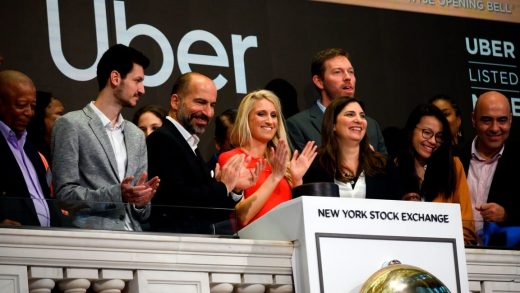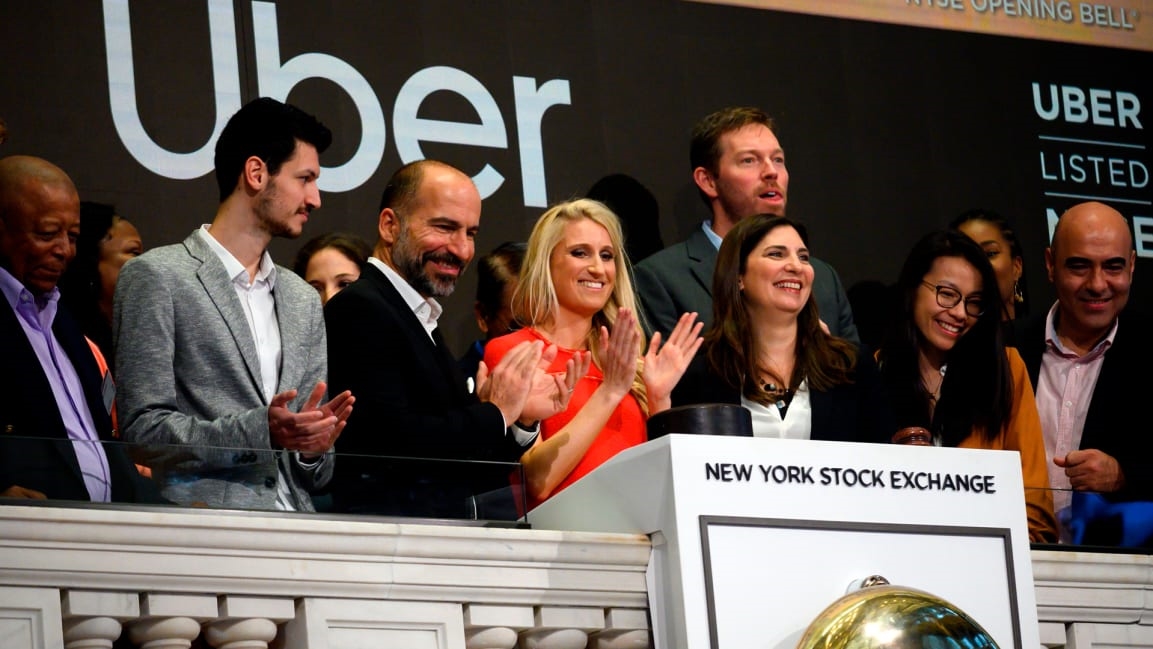Uber went public, and a bunch of rich people got richer
The most built-up public offering of the app economy has arrived. This morning, Uber went public at $42 per share. The opening trade was down from the $45 price it set last night. It was an anticlimactic debut for the ride-hailing giant, although the overall market was also down this morning. But now that Uber is trading on the New York Stock Exchange, the real work begins.
Uber’s success as a public company, as well as that of U.S. rival Lyft–which went public six weeks ago–depends on its ability to steal away market share from public transport and personal car ownership. “It underlines what is going to be the critical challenge for Uber . . . which is trading off short-term earnings on long-term growth,” says Arun Sundararajan, a professor at New York University’s Stern School of Business and the author of The Sharing Economy. He estimates Uber and Lyft currently capture an estimated 1% of consumer spending on transportation.
Indeed, there is already some evidence that ride-hail platforms are eating into public transit use, and Sundararajan says it’s conceivable that 10% of U.S. consumer spending on personal transportation could be on platforms like Uber or Lyft within a few years.
But both companies have to be prepared to take losses in order to maintain a stronghold in dense urban areas and keep fares low enough to convince people outside of major metropolitan hubs to hail a car instead of driving themselves, Sundararajan says. For Uber, achieving profitability will require heavy spending on its food delivery and freight business. Already, Uber Eats is showing great potential, making up 13% of sales.
The scenic route
How big is Uber’s actual opportunity? That’s still unclear. For ride hailing, there has been great promise in the idea that everyone can share cars, and that personal car ownership will become at least slightly less necessary. But that hasn’t been the case yet. Urban congestion has actually gotten worse, and in some cities, car ownership is on the rise. Furthermore, Uber continues to lose a lot of money, and its massive growth trajectory is slowing. Ride-hail revenues increased 95% from $3.5 billion to $6.9 billion between 2016 and 2017. The following year, revenues grew only 33% to $9.1 billion. There’s also some concern about how much riders are actually using the platform.
“Users are growing more than 10% quarter over quarter, more than 30% year over year. But the number of rides per user has stopped growing three quarters ago at 5.5 per user. That’s why there is a lot of concern,” Pierre Ferragu, an analyst for New Street Research, said on Bloomberg TV at the end of April. “I think as long as you have very, very fast growth in the number of users, it is difficult to see the growth in usage, in the number of rides per user, because the new users you’re adding to your user base are just starting to use the service, have low usage–they are pulling down the number of rides per users.”
There is a quite a bit of opacity around what kind of growth potential Uber ultimately has going forward, and even if it does grow, there’s little clarity on when, or how, it will become profitable. Uber, in its filing with the Securities and Exchange Commission, said as much when it warned it “may not achieve profitability” in the section concerning risk factors.
Analysts concur. “Uber’s been in business since 2009, yet, according to its own reports, it had negative cash flow last year of $2 billion and pays interest on $4 billion in debt,” says Jeff Yastine, a senior equities analyst at Banyan Hill Publishing. “If a company can’t at least be EBITDA positive during a decade-long bull market, with zero interest rates and the easiest of ‘easy money’ policies by the Fed . . . well, what further ‘help’ does it need to turn a profit?”
Uber has been using venture capital to subsidize low-cost rides for users. As it starts to raise prices, consumers may drop off. Investors are excited about Uber’s public offering, but the IPO may mostly be a way to let the venture capitalists, who have long supported the brand, cash out. New shareholders will have contend with how Uber becomes profitable–and if it can.
Amid these concerns are yet more big questions about how regulation will affect the company. In New York, the Taxi Workers Alliance convinced city government to instill a one-year cap on new ride-hail licenses and a $17.22-per-hour wage minimum. In London, Uber is working under a 15-month probationary license after Transport of London initially revoked the company’s license over safety concerns.
The driver question
On Wednesday, ahead of the IPO, Uber and Lyft drivers in cities across the globe went on strike over wages and working conditions. Another battle happening in parallel is over a question of whether drivers for Uber and Lyft should be classified as contractors or employees. In March, Uber settled a class-action lawsuit with drivers not bound by arbitration agreements for $20 million, in order to avoid reclassifying workers. Both Uber and Lyft have stated in SEC filings that if either were to have to make drivers declared to be employees, their businesses would be aversely affected.
Currently, Uber pays drivers a fee for driving based on miles driven, time spent driving, and demand for rides. Giving drivers a flat fee per hour or set hours could add significant cost to Uber.
“Even if the United States classifies platform drivers as employees,” says Sundararajan, “the company that will be able to absorb that more easily is Uber. From a competitive point of view, having contractors classified as employees might actually help.”
Those who are bullish on the company compare it to Amazon, which was unprofitable for years as a public company. Uber CEO Dara Khosrowshahi agrees there are similarities between Uber and Amazon but acknowledges Amazon was a much younger company when it went public.
“We are much bigger, much more mature as a company as we go public, and if you do look at the growth rates, our audience is growing 33% on a year on year basis, transactions are growing 36%. To be able to grow transactions 36% on a $50-billion base is pretty incredible, and we hope to keep it going,” he told CNBC.
Amazon lured customers to online shopping with subsidized prices on goods, had almost no competition, and now commands half of all U.S. e-commerce marketshare. But it also built out other businesses like AWS that support its current profitability. There are a lot of elements threatening Uber’s ride-hail business from ever becoming profitable, though the company says it is profitable in some markets. While its side businesses, Eats and Freight, hold promise, neither are poised to be Uber’s AWS.
Meanwhile, others are not so keen on the Amazon comparison. “It worked for Amazon, but Amazon was at least cash-flow positive within a few years of opening its doors,” says the analyst Yastine. “As a general rule, if a company can’t show a real profit in four or five years of steady operations, I doubt it will ever show a profit.”
(20)



